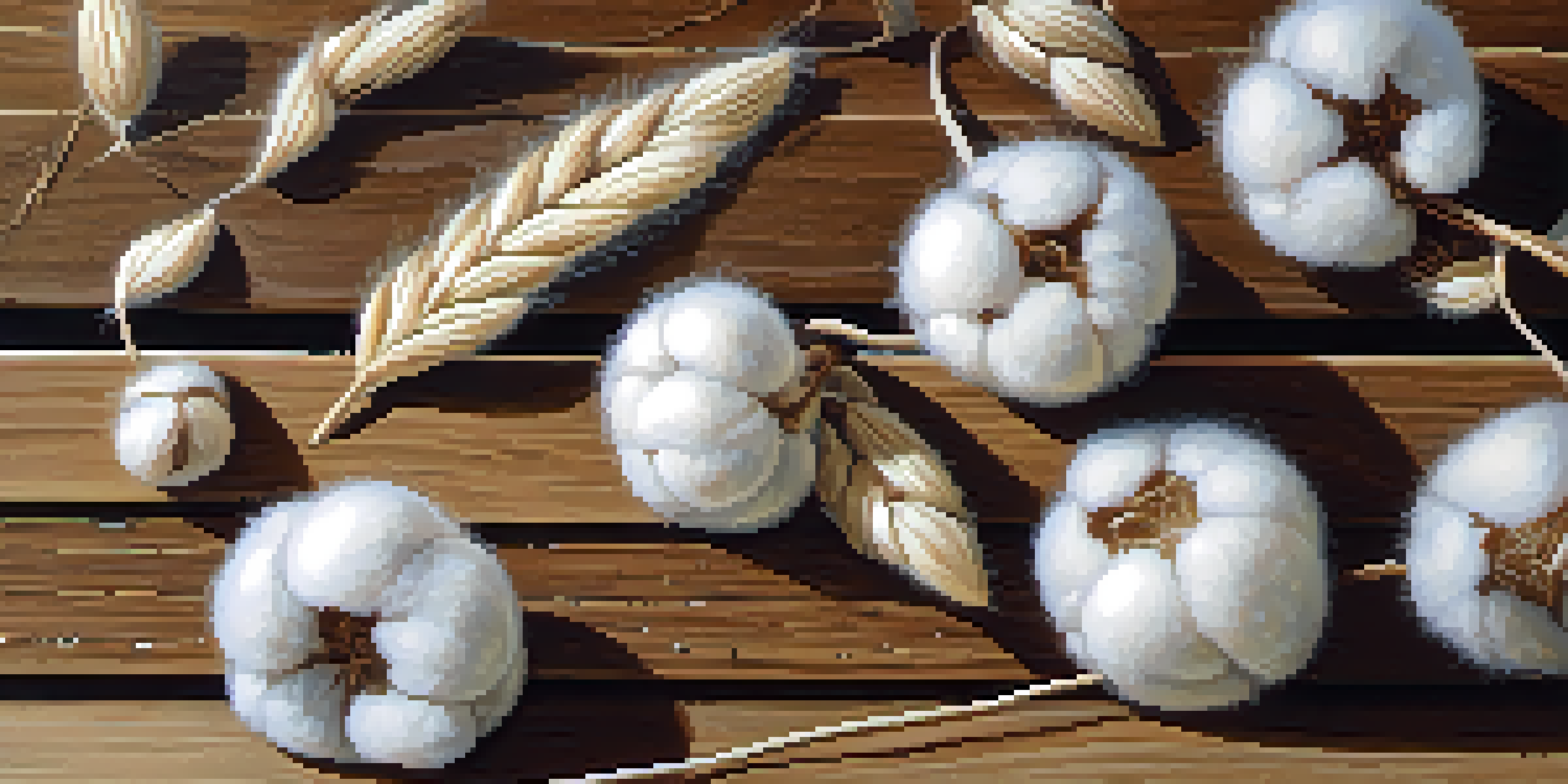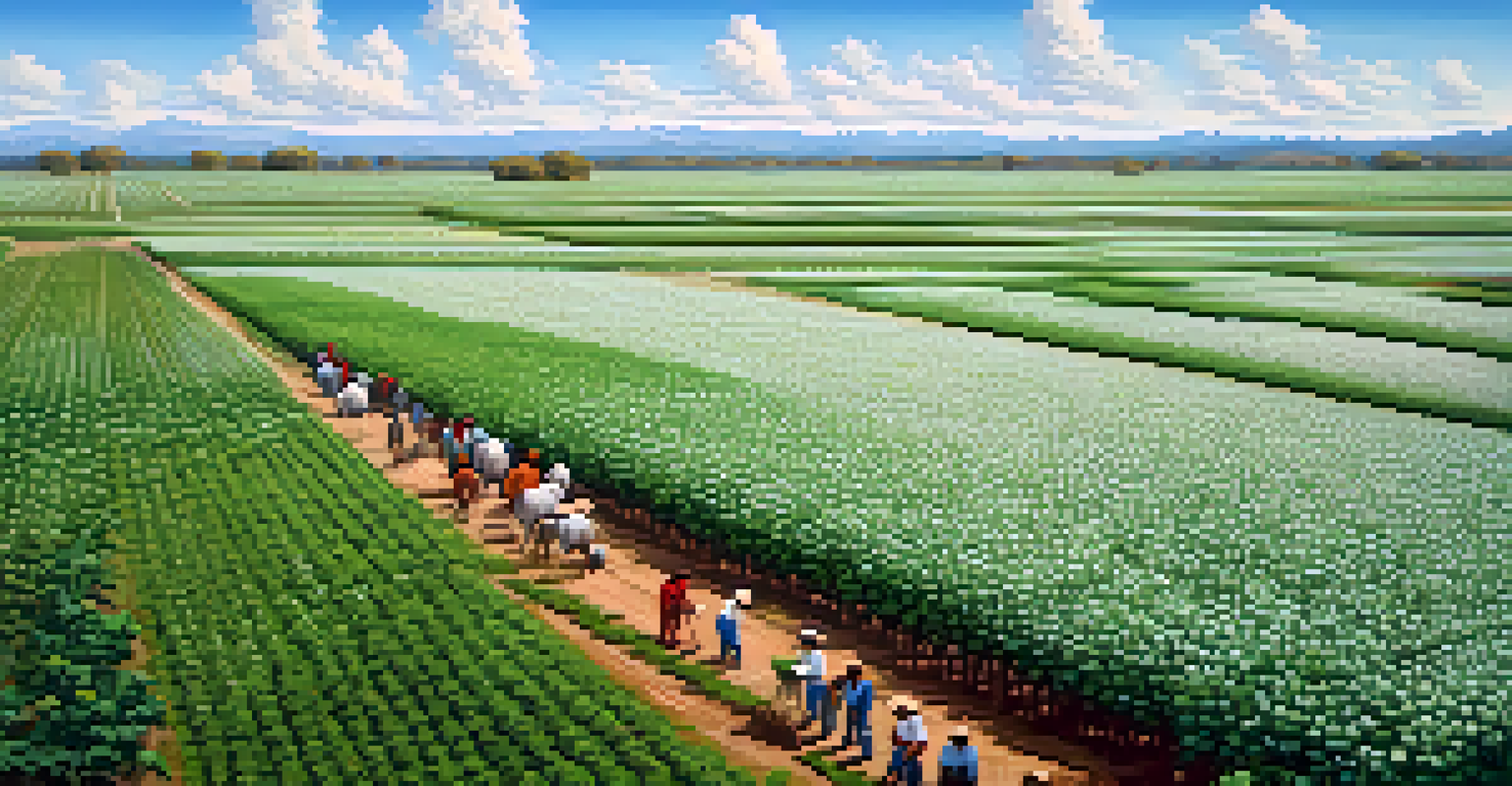The Role of Agriculture in Plant Fiber Textile Production

Understanding Plant Fibers and Their Importance
Plant fibers are natural materials derived from plants, essential in creating textiles. They come from various parts of plants, such as leaves, stems, and seeds, and are known for their durability and comfort. Common examples include cotton, linen, and hemp, each offering unique qualities that make them suitable for different types of fabrics.
The greatest threat to our planet is the belief that someone else will save it.
The significance of plant fibers extends beyond mere fabric; they play a vital role in the textile industry by providing sustainable and biodegradable alternatives to synthetic materials. As consumers become increasingly eco-conscious, the demand for plant-based textiles has surged, prompting a shift towards more sustainable production methods.
This increasing interest in plant fibers not only benefits the environment but also supports agricultural communities. By cultivating crops specifically for fiber production, farmers can diversify their income sources, contributing to economic stability and promoting sustainable agricultural practices.
The Agricultural Practices Behind Fiber Production
The journey of plant fibers begins in the fields, where specific crops are cultivated for their fibrous properties. Farmers employ various agricultural practices, such as crop rotation and organic farming, to enhance the quality and yield of fiber plants. These methods not only improve soil health but also reduce the need for harmful pesticides and fertilizers.

For example, cotton, one of the most widely used plant fibers, requires careful management of water resources and pest control methods to ensure a successful harvest. Innovations in agricultural technology, like precision farming, are helping farmers optimize their practices to produce high-quality fibers while minimizing environmental impact.
Plant Fibers Boost Sustainability
Plant fibers provide eco-friendly alternatives to synthetic materials, supporting sustainable textile production.
Moreover, growing awareness of sustainable farming has led to an increase in organic cotton production. This shift not only caters to the eco-friendly market but also fosters healthier ecosystems, showcasing how agriculture can play a pivotal role in the textile supply chain.
The Processing of Plant Fibers for Textiles
Once harvested, plant fibers undergo several processing stages to transform them into usable textiles. This process often includes retting, washing, and spinning the fibers, each step crucial for enhancing the fiber's strength and texture. For instance, flax fibers are soaked in water to facilitate the separation of the fibrous strands during retting.
Sustainability is no longer about doing less harm. It’s about doing more good.
After processing, these fibers are spun into yarn, which can then be woven or knitted into various textile products. The techniques used in this phase can significantly impact the final fabric's quality, appearance, and feel. As such, knowledge of both traditional and modern processing techniques is essential for textile manufacturers aiming to produce high-quality products.
Furthermore, advancements in technology, such as automated spinning machines, have revolutionized fiber processing, increasing efficiency and reducing labor costs. This evolution not only streamlines production but also opens up new opportunities for innovation in textile design and sustainability.
Sustainability in Agriculture and Textile Production
Sustainability is a guiding principle in the modern textile industry, encouraging practices that protect the environment and support communities. Agriculture plays a crucial role in this, as sustainable farming methods can significantly reduce the ecological footprint of plant fiber production. Techniques like agroforestry and intercropping enhance biodiversity and soil health while providing valuable resources.
For instance, hemp is often cited as a sustainable crop due to its low water requirements and ability to grow in diverse soil conditions. By integrating such crops into agricultural systems, farmers can contribute to a more resilient and sustainable textile supply chain.
Economic Growth Through Fiber Farming
Diversifying into plant fiber cultivation helps farmers stabilize income and strengthens local economies.
Moreover, the emphasis on sustainable agriculture is pushing brands to rethink their sourcing practices. As consumers demand transparency, many companies are now prioritizing partnerships with farmers who adhere to ethical and sustainable farming standards, thus ensuring that the entire production process is environmentally friendly.
Economic Impact of Plant Fiber Production on Agriculture
The cultivation of plant fibers has significant economic implications for agricultural communities. By diversifying their crop production to include fiber plants, farmers can stabilize their income and reduce the risks associated with monoculture farming. This adaptability is crucial in an ever-changing market influenced by climate change and consumer preferences.
Additionally, as the demand for sustainable textiles grows, farmers who produce plant fibers can tap into new markets, potentially increasing their profit margins. This shift not only benefits individual farmers but also strengthens local economies and supports rural development.
Moreover, the rise of ethical fashion brands focusing on sustainable and natural materials creates job opportunities throughout the supply chain, from farming to processing to retail. This interconnectedness between agriculture and the textile industry highlights the importance of nurturing these relationships for economic sustainability.
Challenges in Plant Fiber Agriculture and Textile Production
Despite the benefits, there are also challenges associated with plant fiber agriculture. Climate change poses a significant threat, affecting crop yields and making it difficult for farmers to predict growing seasons. Extreme weather events can devastate fiber crops, leading to supply shortages and increased prices in the textile market.
Moreover, the transition to sustainable farming practices often requires upfront investment and education, which can be a barrier for some farmers. Access to resources, training, and technology is essential for effectively implementing these practices and achieving long-term sustainability.
Challenges in Sustainable Practices
Despite their benefits, climate change and resource access hinder the transition to sustainable plant fiber agriculture.
Lastly, the textile industry itself faces challenges regarding consumer awareness and demand for sustainable products. Although interest is growing, many consumers are still unaware of the benefits of plant-based textiles, highlighting the need for increased education and marketing efforts to promote sustainable choices.
The Future of Agriculture in Textile Production
Looking ahead, the future of agriculture in textile production appears promising, especially as sustainability takes center stage. Innovations in agricultural practices, such as regenerative farming, could revolutionize how plant fibers are grown and processed, further enhancing their environmental benefits. These methods aim to restore soil health and increase biodiversity, creating a more robust agricultural ecosystem.
Additionally, advancements in technology, such as bioengineering and sustainable pest management, offer exciting possibilities for improving crop resilience and yield. As researchers continue to explore these avenues, the textile industry will likely benefit from more reliable and sustainable sources of plant fibers.

Ultimately, the growing demand for eco-friendly textiles will drive further collaboration between farmers and textile producers. By working together, they can create a more sustainable and ethical supply chain that not only meets consumer needs but also supports the environment and agricultural communities.